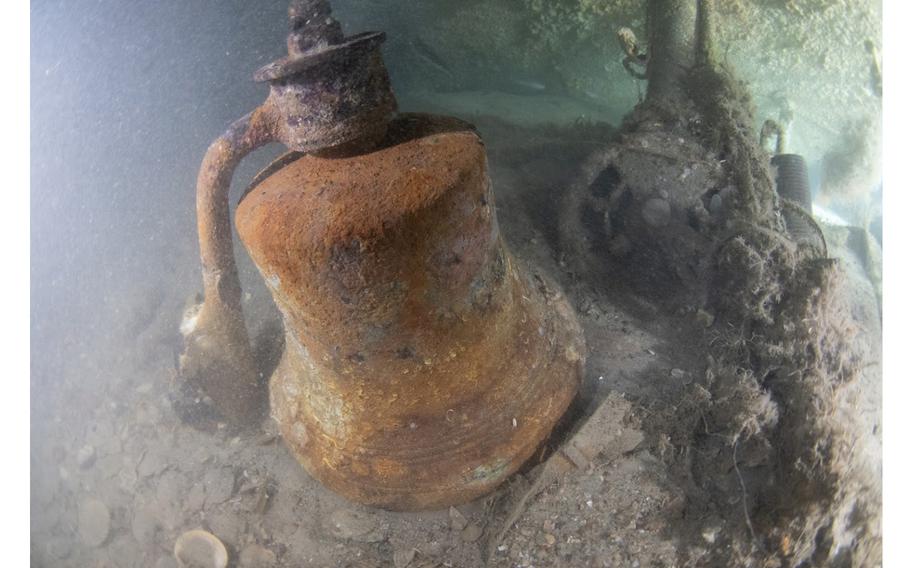
The bell of the USS Jacob Jones, an American destroyer sunk during World War I. The shipwreck was discovered by a British dive team in 2022. (Rick Ayrton)
The crew of the USS Jacob Jones spotted the German torpedo coming at them from 1,000 yards away.
The American destroyer was steaming alone in the Atlantic, 25 miles from Bishop Rock, off the southwest coast of Britain, unaware that it was being stalked by a U-boat, an enemy submarine.
Someone yelled, “Torpedo!” The ship tried to veer out of the way. But the torpedo struck home, blew up and the Jacob Jones sank in eight minutes, taking 64 sailors down with it.
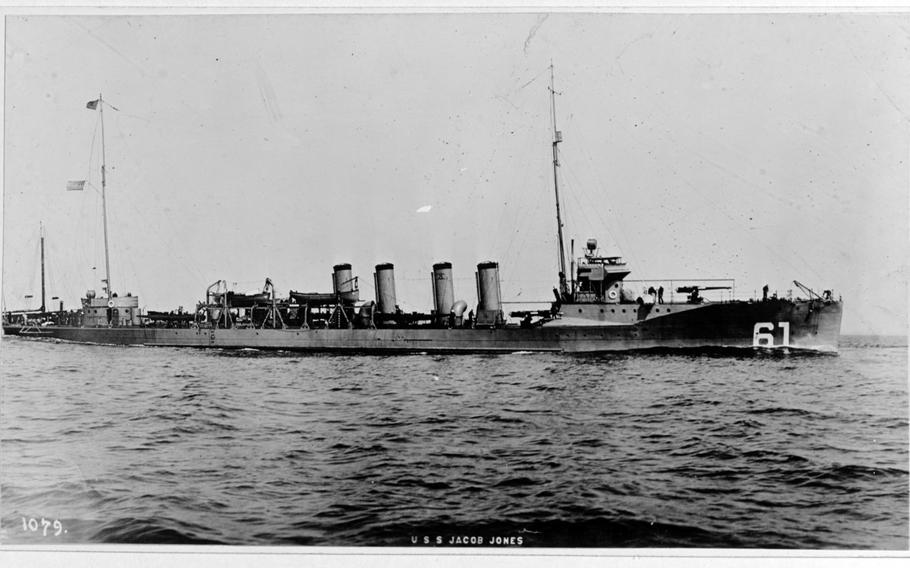
The USS Jacob Jones was struck by a torpedo fired from a German submarine in World War I. (Naval History and Heritage Command)
It was 4:21 p.m. on Dec. 6, 1917, eight months after the United States entered World War I. The Jacob Jones became the first U.S. destroyer to be lost to enemy action, the Navy says.
Last month, at the behest of the Naval History and Heritage Command in Washington, a British government diving unit retrieved the ship’s bell from the wreck, almost 400 feet below the water’s surface, where it had rested for more than a century.
Plans are to return the bell to the command at the Washington Navy Yard as soon as this spring. It will go to the command’s underwater archaeology lab for conservation.
“We’ve been told the clapper is still in place,” and that the bell rang during handling, Alexis Catsambis, head of the Underwater Archaeology Branch, said last week.
The British Defense Ministry’s Salvage and Marine Operations raised the bell — which still bears the imprints “Jacob Jones” and “1915” — on Jan. 15 with the grabbing arm of an underwater robot, the ministry and the history command said.
“The ship is a war grave,” retired Rear Adm. Samuel J. Cox, director of the history command, said on Feb. 12. “This is just an opportunity to remember the sacrifice of those sailors.”
“What they did escorting the convoys is basically what won the war,” he said, referring to U.S. ships that helped guard cargo vessels loaded with goods for U.S. allies in Europe.
The wreck was found in 2022 by private divers from the British Darkstar technical dive team. “Finding the USS Jacob Jones was the sort of thing that fills the dreams of most divers,” Dom Robinson, one of the divers, said in an email last week.
“We were also acutely aware of the history and how many young sailors had died on the wreck but were pleased that we … finally located their resting place,” he said.
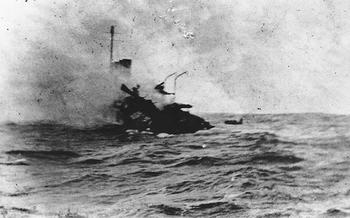
The USS Jacob Jones was sunk by the German submarine U-53 on the night of Dec. 6, 1917. (Naval History and Heritage Command/Smithsonian Institution)
The 80-pound brass bell was on its side when they first spotted it in the dark water. “We flipped it upright so we could read the name and confirm the identity,” he said.
The divers filmed and photographed the discovery, and received extensive publicity. Cox praised the Darkstar team for its care but was alarmed by all the attention. The Navy usually does not disturb a wreck site, he said, but this case was unusual.
“The bell was laying out there and had this kind of ‘take me’ stamped on it,” Cox said. “Just about every wreck from World War I, World War II [in waters around Britain] has had anything valuable stripped from it.”
“Bronze, brass, especially,” he said. “It’s gone.”
He added, “We didn’t want to take the chance of someone running off with the bell.”
The command had originally planned to investigate the wreck with partner organizations this summer, Catsambis said.
“We wanted to visit the site, and document it, and get some good imagery of it,” as well as recover the bell, he said on Feb. 13.
Then, the command heard that the British Defense Ministry was testing a new underwater robotic vehicle, he said.
“And they were able and willing to lend a hand, which I think is a particularly fitting part of the story, seeing as Jacob Jones was there doing the same 100 years ago,” he said.
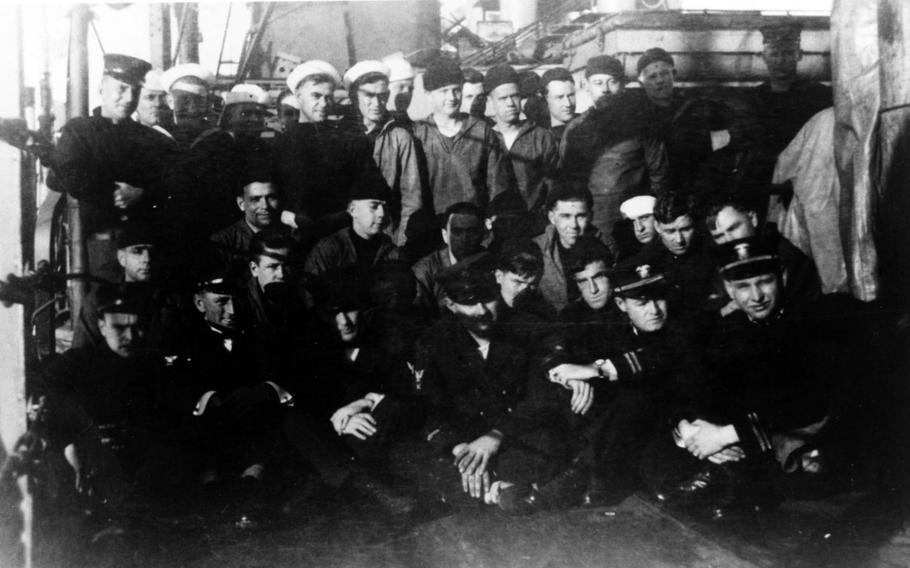
Survivors of the sinking of the USS Jacob Jones. (Courtesy of Commander Donald J. Robinson and the Naval History and Heritage Command)
The bell is in the custody of Wessex Archaeology in Salisbury, England, about 90 miles southwest of London, awaiting its return to the United States.
The Jacob Jones was built at the New York Shipbuilding Corp. in Camden, N.J., and was launched on May 29, 1915, according to the Navy. After the United States entered World War I in April 1917, the destroyer began escorting convoys and rescuing survivors of ships torpedoed by enemy submarines.
On Dec. 6, the destroyer was en route from Brest, France, to the Irish seaport of Queenstown, now Cobh, when it was attacked by the German submarine, U-53, which had already damaged or sunk 70 ships during the war.
The sub fired a single torpedo.
The destroyer’s crew spotted it streaking toward them, occasionally breaking the surface as it closed in. Officers ordered full speed ahead and turned the ship hard to try to get out of the way. Lt. Cmdr. David W. Bagley, the skipper, later reported:
The torpedo … jumped clear of the water at a short distance from the ship, submerged 50 or 60 feet from the ship and struck approximately 3 feet below the waterline. …
I attempted to send out an “S.O.S.” message by radio, but the mainmast was carried away, antennae falling and all electric power failed. …
The ship sank about 4:29 p.m. (about eight minutes after being torpedoed). As I saw her settling rapidly, I ran along the deck and ordered everybody I saw to jump overboard.
The ship sank stern first and [twisted] slowly through nearly 180 degrees as she swung upright. From this nearly vertical [position], bow in the air … she went straight down.
The frigid water was soon filled with American sailors struggling to survive.
Many of the 110 men on the ship had been killed when the torpedo exploded. Others were trapped below deck and went down with the wreckage. Some were pulled under by the suction of the sinking vessel. Still others died of exposure on life rafts and their bodies were dropped into the ocean, Bagley reported.
About 20 minutes after the sinking, U-53 surfaced a few miles away. It slowly approached to within 800 yards, picked up two badly injured U.S. sailors, then submerged. (The two sailors survived.)
The sub’s commander, Hans Rose, radioed the approximate location of the sinking to the U.S. base at Queenstown and asked to be given an hour to get out of the area, according to accounts of the incident on the history command’s website.
Rose was a daring commander. By the end of the war, he had sunk or damaged 91 ships and had earned the Pour le Merite decoration, also called the Blue Max, for gallantry, according to the uboat.net website.
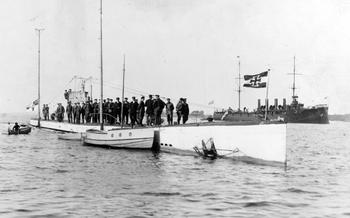
The German submarine U-53, which torpedoed the USS Jacob Jones, is seen in the harbor of Newport, R.I., in 1916, before the United States entered World War I. (Naval History and Heritage Command)
In the summer of 1916, before the United States entered the war, Rose steered U-53 into the harbor of Newport, R.I., for an unannounced visit.
He paid courtesy calls to Navy officials and hosted visitors aboard his submarine. His boat was photographed with the crew standing on deck.
One of the other ships in the harbor that day was the USS Jacob Jones.
After World War I, a second destroyer named Jacob Jones was built at the same New Jersey ship yard. During World War II, it conducted scout and escort duties similar to its namesake a generation before.
At dawn on Feb. 28, 1942, according to the Navy, it was torpedoed and sunk by a German U-boat off the coast of Delaware.